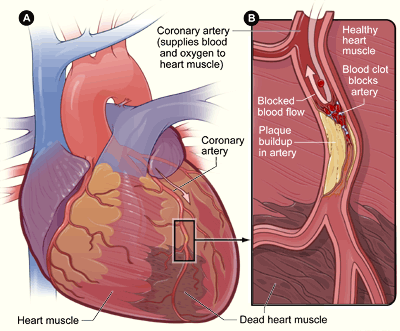What Are the Signs and Symptoms of Coronary Artery
Disease?
A common symptom of coronary artery disease (CAD) is
angina.
Angina is chest pain or discomfort that occurs when your heart muscle doesn't
get enough oxygen-rich blood.
Angina may feel like pressure or a squeezing pain in
your chest. You also may feel it in your shoulders, arms, neck, jaw, or back.
This pain tends to get worse with activity and go away when you rest. Emotional
stress also can trigger the pain.
Another common symptom of CAD is shortness of
breath. This symptom happens if CAD causes
heart
failure. When you have heart failure, your heart can't pump enough blood
throughout your body. Fluid builds up in your lungs, making it hard to breathe.
The severity of these symptoms varies. The symptoms
may get more severe as the buildup of plaque continues to narrow the coronary
arteries.
Signs and Symptoms of Heart Problems Linked to
Coronary Artery Disease
Some people who have CAD have no signs or symptoms.
This is called silent CAD. It may not be diagnosed until a person show signs
and symptoms of a
heart
attack, heart failure, or an
arrhythmia
(an irregular heartbeat).
Heart Attack
A heart attack happens when an area of plaque in a
coronary artery breaks apart, causing a blood clot to form.
The blood clot cuts off most or all blood to the
part of the heart muscle that's fed by that artery. Cells in the heart muscle
die because they don't receive enough oxygen-rich blood. This can cause lasting
damage to your heart. For more information, see the animation in
"What
Causes a Heart Attack?"
Heart With Muscle Damage and a
Blocked Artery

Figure A is an overview of a heart
and coronary artery showing damage (dead heart muscle) caused by a heart
attack. Figure B is a cross-section of the coronary artery with plaque buildup
and a blood clot.
The most common symptom of heart attack is chest
pain or discomfort. Most heart attacks involve discomfort in the center of the
chest that lasts for more than a few minutes or goes away and comes back. The
discomfort can feel like pressure, squeezing, fullness, or pain. It can be mild
or severe. Heart attack pain can sometimes feel like indigestion or heartburn.
Heart attacks also can cause upper body discomfort
in one or both arms, the back, neck, jaw, or stomach. Shortness of breath or
fatigue (tiredness) often may occur with or before chest discomfort. Other
symptoms of heart attack are nausea (feeling sick to your stomach), vomiting,
lightheadedness or fainting, and breaking out in a cold sweat.
Heart Failure
Heart failure is a condition in which your heart
can't pump enough blood to your body. Heart failure doesn't mean that your
heart has stopped or is about to stop working. It means that your heart can't
fill with enough blood or pump with enough force, or both.
This causes you to have shortness of breath and
fatigue that tends to increase with activity. Heart failure also can cause
swelling in your feet, ankles, legs, and abdomen.
Arrhythmia
An arrhythmia is a problem with the speed or rhythm
of the heartbeat. When you have an arrhythmia, you may notice that your heart
is skipping beats or beating too fast. Some people describe arrhythmias as a
fluttering feeling in their chests. These feelings are called palpitations.
Some arrhythmias can cause your heart to suddenly
stop beating. This condition is called
sudden
cardiac arrest (SCA). SCA can make you faint and it can cause death
if it’s not treated right away.
For more information, see the animations in
"Types
of Arrhythmia."
|

